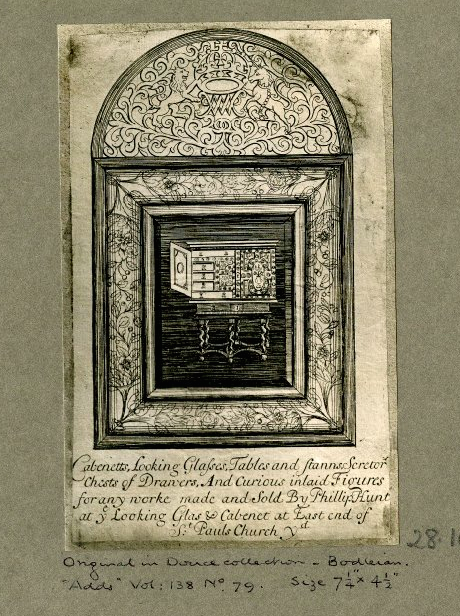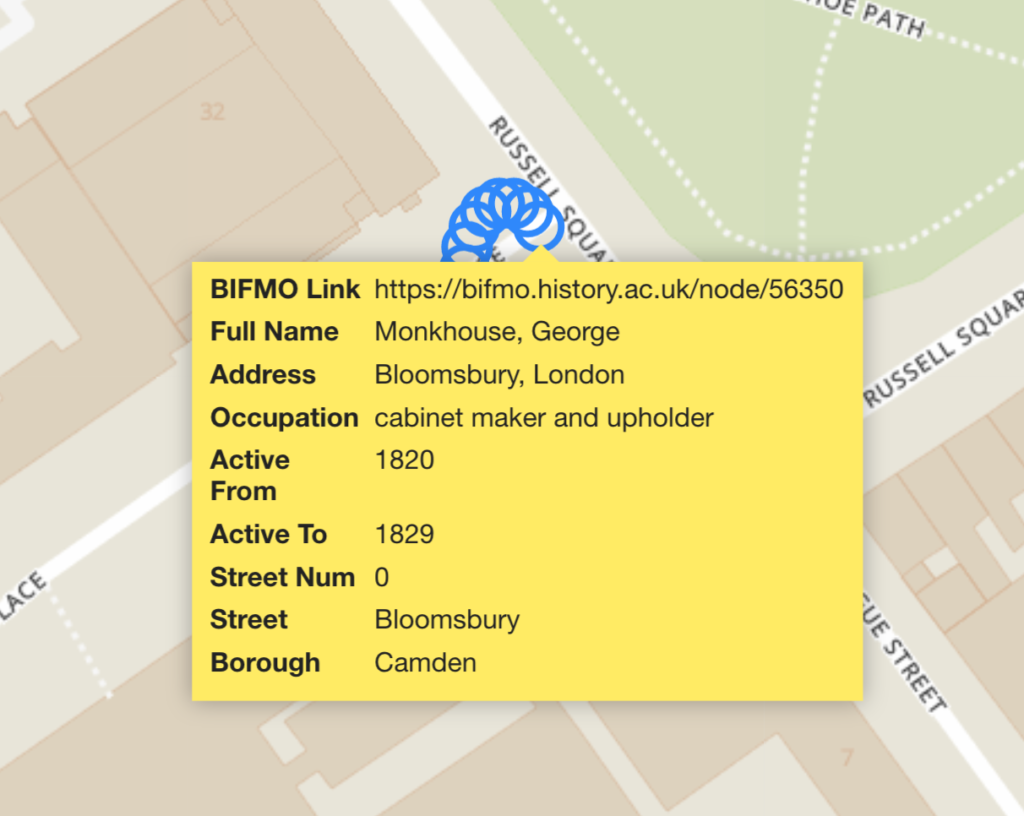By Adriana Turpin
The British and Irish Furniture Makers Online (BIFMO) project is a partnership between the Institute of Historical Research and the Furniture History Society. It encompasses research, resources, training and events to engage with a global community of researchers, students, genealogists and the art trade.
At its heart is the BIFMO website: a 70,000 person biographical repository of information relating to British and Irish furniture makers and the furniture trade, covering the period 1640-1914. In a new development, BIFMO is now intersecting selected data with another IHR project — Layers of London — to investigate and map furniture makers across the capital in the long eighteenth century.
The British and Irish Furniture Makers Online (known as ‘BIFMO’) is a freely accessible database of 70,000 British and Irish furniture makers, active across the British Isles between the mid-seventeenth and nineteenth century. It’s been developed in collaboration with the Furniture History Society, which is supporting research to write new biographies and to add recently discovered information relating to those makers already included in the resource.
In addition to this, we’re exploring new ways of visualizing segments of data: first, through the creation of network graphs which map the relationship of makers in time and by place (and discussed in a previous post by the furniture historian, Dr Laurie Lindey); and, second, by mapping records of selected makers to historical maps of London to show the trade’s urban distribution.
The furniture makers of London
Of the 70,000 makers in BIFMO, more than 15,000 had a personal or professional association with London. Furniture making was one of the largest industries in the capital during the proto-industrial period and into nineteenth century.
BIFMO data are particularly good for charting the places where these activities occurred. Records in BIFMO document where, in London, furniture makers and retailers lived and worked (either in workshops or on commission), and what they made and sold.
Existing BIFMO place data are rich, drawing on earlier generations of scholarship and providing information on the sites of furniture making across the capital. In thousands of cases, this rich place data relate to house numbers, street names and districts, allowing us to search for people by defined geographical regions within the capital.
In BIFMO you’ll therefore find records relating to 165 craftspeople associated with Lambeth, 114 people with professional links to Bloomsbury, and 95 with Spitalfields, together with 224 records for furniture makers on Oxford Street or 28 on Great Russell Street, close to the British Museum.

The geographical locations of London craftsmen can be further enhanced using a growing array of archival sources, including trade cards, newspaper advertisements, and tax and parish records. Many of these sources are now available digitally, and therefore accessible to today’s biographers and furniture historians to an extent unimaginable to earlier researchers. These new sources, among others, are now helping us to supplement and extend BIFMO’s coverage: with new biographies and extra information on people already included in the resource.
Updates to thousands of BIFMO records have now been researched and will shortly begin to be published as updates to the site. In this way, the store of information relating to the historical furniture trade will become more extensive, more accurate and more nuanced as new discoveries are made.
Mapping makers to Layers of London
From these records, with their enhanced place data, we can begin to show how the industry developed as steam power and new manufacturing processes were introduced. These innovations led some of the trade to adapt their organisational structures: from small networks of workshops specialising in particular types of furniture – such as chairs or cabinets – to factories that produced a range of products on an industrial scale.

To better understand these development we have now plotted BIFMO’s rich place data on a selection of online maps of the early modern metropolis. Records for 2750 London furniture makers, active between the Restoration and 1840, have recently been added to another IHR project: the digital mapping platform, Layers of London. Layers is a map-based history project that allows anyone to access free historic maps of London and to contribute stories, memories and histories to create a social history resource about their area.

These 2750 furniture makers were chosen on account of the richness of place data associated with an individual — down to the house numbers for the premises at which they lived, worked or traded. This level of detail has enabled staff from Layers of London and the IHR’s Digital group to geo-reference these locations to the exact point on modern-day maps. In doing so we’re able to visualize the distribution of furniture maker’s homes and premises over the long eighteenth century.
The resulting map is scalable to show patterns of city-wide distribution, alongside much closer views of neighbourhoods and streets. Individual records (each marked by a blue circle on the map) then ‘open up’ to provide a copy of that craftsperson’s record within BIFMO: with details of his or her specialism, residence, and and dates of known association with that place.

Via the ‘BIFMO link’ option, individual records also connect back to a person’s entry in the BIFMO resource, where further biographical information is often available. Prominent figures within the trade receive often lengthy biographies in BIFMO, charting their careers and principal works and commissions. Equally, shorter entries for less prominent makers often include references to business partners and associates from which we can now build up a better understanding of the networks that underpinned the early modern furniture trade.

BIFMO data are ideally suited to this form of visualization from which researchers can plot and identify broader patterns in the development of trades over time. For example, in early modern London the furniture trade — like so many others — was concentrated in the City before expanding westward into Covent Garden, St. Martin’s Lane, Soho and Piccadilly, and northward to Bloomsbury and beyond by the early Victorian period. In the early twentieth century, large furniture firms such as that of the influential designer, Gordon Russell, were established in then ‘out-of-town’, sites such as Park Royal in west London.

A Gordon Russell factory worker polishes a Murphy radio cabinet at their site at Park Royal © The Gordon Russell Design Museum
Using Layers of London, this plotting of London furniture makers can also be viewed on a range of historical maps that correspond with the dates of people active in the area: for example, as shown below, the use of an 1828 map from the Layers selection of 15 historical maps, combined with makers active in the area west and north of the Tower of London.

We hope that this first exercise in mapping London’s historical furniture makers will help researchers to think about the historical location of the trade, and its shifts over time.
More broadly, the Layers of London project covers a very wide range of mapping activities, covering maps, topics and themes from the medieval to the modern period.

If you’re interested in getting involved with Layers of London, there will be training sessions throughout the year for anyone who wants to add images, photographs, stories or just a line of information. Details of forthcoming training sessions can be found via the Volunteering section of the Layers of London site.
BIFMO conference, 17 October: exploring the future of furniture history
On Thursday 17 October, we’ll be exploring further the possibilities of mapping London’s furniture trades at a half-day conference on the applications of the BIFMO platform and its potential for new research in the history of British and Irish furniture making. The conference, which is sponsored by the Foyle Foundation, will take place at the MacMillan Hall, Senate House, University of London, between 2.30 and 6.30pm. Admission is free but booking is essential.

Two panels at the conference will consider the creation and digital development of the BIFMO platform, followed by studies of trans-Atlantic and English regional furniture making. A closing roundtable discussion will feature contributions from eminent furniture experts and historians, representing the Victoria & Albert Museum, the Genealogical Society, the IHR’s Victoria County History and also the Layers of London project. Staff from the Layers project will discuss in greater detail the opportunities for mapping London’s furniture trades to digital representations of the eighteenth-century city.
Full details of the BIFMO conference on 17 October 2019, and how to register, are available here. For queries, please contact bifmo.research@gmail.com.
To explore the 2750 furniture makers mapped to London, visit the Layers of London site.
Adriana Turpin is Project Manager for BIFMO on behalf of the Furniture History Society.

